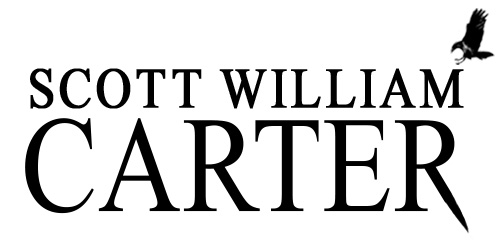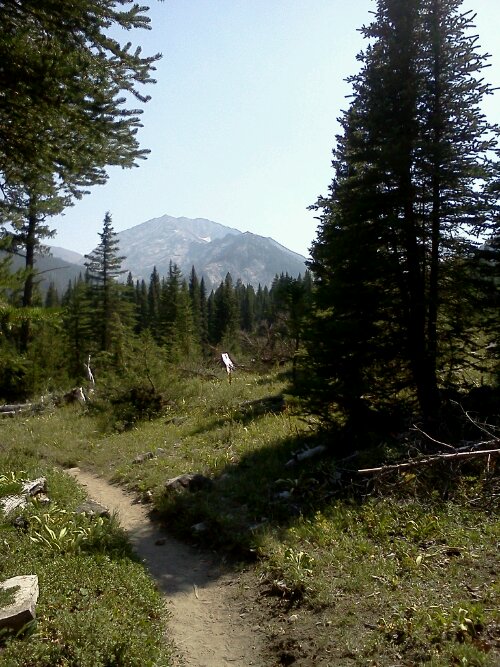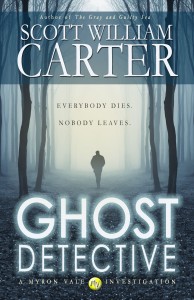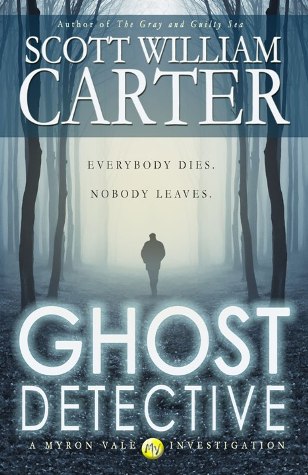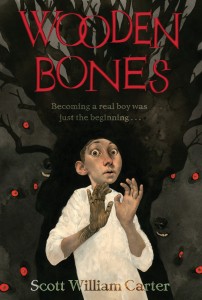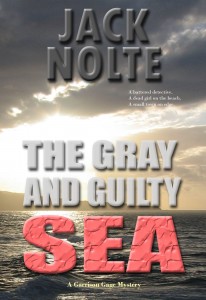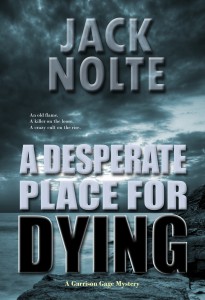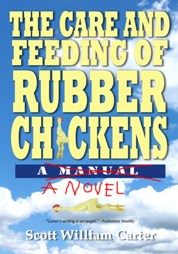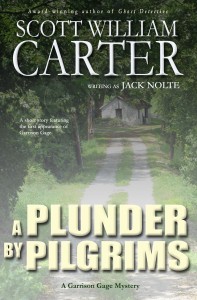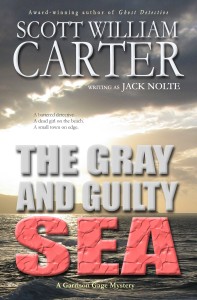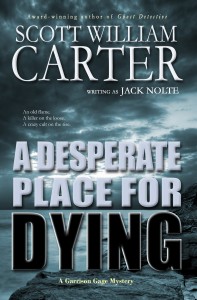It’s been a busy summer and it’s hard to believe that September is only a few weeks away. Just back from a week-long camping trip with the family at Wallowa Lake, where we took a gondola ride up the Wallowa Lake Tramway, rode horses into the foothills of Mt. Joseph, explored Wallowa Lake in a little rented motorboat, played miniature golf, ate smores around a campfire, and went on a fun afternoon hike at Hurricane Creek with panoramic views of Sacajawea, Matterhorn and Eagle Cap Peaks. Here’s a shot from my cell phone I took on our hike:
I also read two books, Zen and the Art of Motorcycle Maintenance by Robert Pirsig, and Flow by Mihaly Csikszentmihalyi. Both have been on my list for some time, and both offered me insights into some writing/art/life issues I’ve been wrestling with lately, which I wasn’t expecting. (Proof perhaps Richard Bach was on to something, I suppose, when he said in his book Illusions that you can open any book and find exactly the guidance you’re looking for at that moment.) I’ll talk about those insights in just a moment, but first I have some tidbits of news I’d like to share.
First, it seems my latest book, Ghost Detective, has been well-received by readers (thank you!) and a number of people have been asking when I’ll be writing a sequel. Rest assured, it’s coming, I certainly set it up to be a series, but I’m working on the next Garrison Gage book first. The Garrison Gage and Myron Vale series are the priority right now (part of the recalibration I mentioned in a blog post a few months back), and I’m gratified that they both have been selling fairly well.
I spent a week in July as an assistant instructor at the Advanced Master Class and had a fantastic (albeit exhausting) time. This was a workshop aimed at professional fiction writers, not beginners, taught mainly by Kristine Kathryn Rusch and Dean Wesley Smith, with a number of other guest speakers throughout the week. I can never truly pay Kris and Dean back for all the help they’ve given me over the years, so I jump at any opportunity to pay it forward to other writers. Mostly, the focus was on helping writers adapt to the tremendous and exciting changes going on in the publishing industry right now, allowing writers to bypass the gatekeepers and go direct to readers. I felt a bit nervous about this one, not because of the teaching, I’m used to getting up in front of people, but because the workshop was pretty much my idea, so if it bombed I would have felt pretty bad at having three dozen people fly from Boston, Houston, Toronto, and even Germany to attend it.  Fortunately, based on the feedback from students, I think people got a lot out of it.
Fortunately, based on the feedback from students, I think people got a lot out of it.
And I learned a ton, too. Always a bonus.
The paperback version of Wooden Bones, my sequel to the Pinocchio story with a twist, is now available. If you’ve been waiting for a cheaper version, now’s your chance. It also looks like Simon and Schuster has also dropped the Kindle price to under $6.
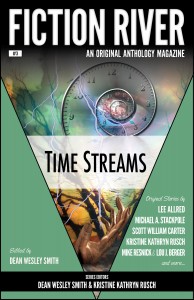 I mentioned yesterday that my story, “The Elevator in the Cornfield,” is currently available as a free podcast from WMG Publishing. A farmer and his son find an elevator in the middle of their cornfield one morning and strangeness ensues. I believe it’s up for just another day or two, so give it a read (er, listen) now if you’re so inclined. The audio version of the whole collection should be available shortly, but you can buy the print or ebook versions now. This is part of the Fiction River anthology series, each book set around a different theme, and I’m proud to be part of it. I have a couple stories in future anthologies as well, and I’ll mention them when the time comes.
I mentioned yesterday that my story, “The Elevator in the Cornfield,” is currently available as a free podcast from WMG Publishing. A farmer and his son find an elevator in the middle of their cornfield one morning and strangeness ensues. I believe it’s up for just another day or two, so give it a read (er, listen) now if you’re so inclined. The audio version of the whole collection should be available shortly, but you can buy the print or ebook versions now. This is part of the Fiction River anthology series, each book set around a different theme, and I’m proud to be part of it. I have a couple stories in future anthologies as well, and I’ll mention them when the time comes.
Now, onto those writing/art/life issues I mentioned earlier. One of the things I realized recently was that some of my personal goals related to my writing career were a little … misaligned. They were goals that may have once been appropriate, but based on my own choices and needs, no longer really motivated me. In fact, in many ways the goals themselves were preventing me from fully embracing the life I have now, making me feel like I was constantly preparing to live the life of a writer rather than just living it. Then I came across this lovely passage from Flow by Mihaly Csikszentmihalyi:
The process of discovering new goals in life is in many respects similar to that by which an artist goes about creating an original work of art. Whereas a conventional artist starts painting a canvas knowing what she wants to paint, and holds to her original intention until the work is finished, an original artist with equal technical training commences with a deeply felt but undefined goal in mind, keeps modifying the picture in response to the unexpected colors and shapes emerging on the canvas, and ends up with a finished work that probably will not resemble anything she started out with. If the artist is responsive to her inner feelings, knows what she likes and does not like, and pays attention to what is happening on the canvas, a good painting is bound to emerge. On the other hand, if she holds on to a preconceived notion of what the painting should look like, without responding to the possibilities suggested by the forms developing before her, the painting is likely to be trite.
Csikszentmihalyi was using painting as a metaphor for the need to adapt your goals as your life changes, but it works on both levels for me. My life itself is just like a book, one I write each day I live. For the longest time, I think I was trying to force a set of goals onto my life no matter how much my life changed, goals that were often making me feel like a failure no matter how much success I’ve had. I started having some success as a writer when I let my fiction just go where it wanted to go instead of forcing it, and now it’s pretty clear to me that I need to do the same with my life. I don’t need to go into the specific changes I’ve made, but needless to say, my goals are no less lofty, driven by the desire to become the best writer I can be, but now they’re also fully my own and allow me to embrace all aspects of my life without all the angst. It’s also prompted me to make a number of small changes to make sure I’m living the life today, now, that I want to live, and not waiting for some arbitrary moment when my “real life” can truly begin.
